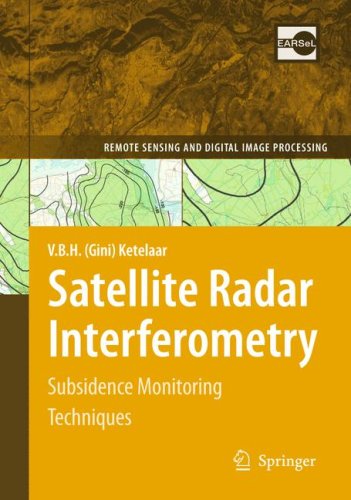V. B. H. (Gini) Ketelaar9781402094279, 1402094272
It provides a review of existing subsidence estimation methodologies using geodetic measurements, explains Persistent Scatterer InSAR (PSI), and proposes a new method for reliability assessment: multi-track datum connection. The presented methodologies are demonstrated for the entire northern part of the Netherlands and a part of Germany (covering ~15.000 km2), using multi-track SAR observations from ESA’s ERS and Envisat satellites.
The capability of PSI for wide-scale monitoring of subsidence rates of several millimeters per year in a rural area (which implies a low PS density) is shown. Additionally, methodologies for a better discrimination of the deformation signal of interest, subsidence due to hydrocarbon production, are assessed.
Essential for operational use, the performance of PSI with respect to the leveling technique is quantified. It is shown that the high spatial and temporal observation density of PSI moreover contributes to the understanding of subsurface processes. For example, subsidence due to gas extraction and subsequent uplift due to underground gas storage is clearly detected.
Table of contents :
Acknowledgements……Page 5
Audience……Page 6
Contents……Page 9
Monitoring Surface Deformation Induced by Hydrocarbon Production Using Satellite Radar Interferometry……Page 13
List of Acronyms and Abbreviations……Page 15
List of Symbols……Page 16
Background……Page 17
Research Objectives……Page 18
Outline……Page 21
Hydrocarbon Reservoirs……Page 25
Reservoir Properties……Page 27
Reservoir Compaction……Page 29
The Compaction Coefficient……Page 30
Subsidence Prediction Methodologies……Page 31
Leveling Campaigns……Page 33
Legal Guidelines……Page 35
Adjustment and Testing Procedure……Page 36
Point-wise Multi-epoch Deformation Analysis……Page 38
Subsidence-Functional Model……Page 39
Subsidence-Stochastic Model……Page 41
Deformation Analysis of Subsidence Due to Gas Extraction……Page 42
Conclusions……Page 43
Interferometric Processing……Page 47
Oversampling……Page 49
Coregistration……Page 50
Persistent Scatterer Selection……Page 52
Identification Methods of PS Candidates……Page 53
Pseudo-calibration……Page 55
Testing Observational Errors……Page 56
Threshold Tuning……Page 57
Master Selection……Page 58
Double-difference Observations……Page 60
Functional Model……Page 61
Integer Least-Squares Estimation……Page 63
Measurement Precision……Page 66
Model Imperfections……Page 67
DePSI Estimation Strategy……Page 68
Conclusions……Page 69
Precision and Reliability in PSI……Page 73
Influence of Imperfections in the Functional Model……Page 74
Sub-pixel Position……Page 75
Sidelobe Observations……Page 76
Orbital Inaccuracies……Page 78
Phase Unwrapping in the Presence of Atmospheric Disturbances……Page 79
Imperfections in the Stochastic Model……Page 81
Separation of Unmodeled Deformation and Atmospheric Signal……Page 82
Possibilities and Limitations of Variance Component Estimation……Page 84
Dilution of Precision……Page 86
Measurement Precision……Page 89
Leveling Precision……Page 90
InSAR A-priori Measurement Precision……Page 91
InSAR and Leveling Double-Difference Displacements……Page 93
Validation of the Stochastic Model……Page 95
InSAR A-posteriori Precision……Page 96
Idealization Precision for Deformation Monitoring……Page 98
Deformation Regimes……Page 99
PS Characterization……Page 100
PS Heights……Page 102
PS Reflectivity as a Function of Viewing Geometry……Page 105
Alternating Polarization……Page 106
PS Selection Based on Spatio-temporal Behavior of the Signal of Interest……Page 108
Decomposition of PS Displacements According to Deformation Regime……Page 111
Conclusions……Page 114
Multi-track PSI……Page 120
Single-Track Datum Connection……Page 121
Orbit Based Radar Coordinate Transformation……Page 123
Matching Using PS Point Fields……Page 126
Matching Using Multi-image Reflectivity Maps……Page 127
Multi-track System of Equations……Page 129
Step-wise Estimation Based on PS Distance……Page 132
Spatial Trends……Page 134
System of Equations……Page 135
Conclusions……Page 136
Data Coverage and Master Selection……Page 140
Generation of Interferograms……Page 145
PS Candidate Selection……Page 147
Parameter Estimation in the First Order Candidate Network……Page 148
Unwrapping Test Procedure and Redundant Parameter Estimation……Page 149
Interpolation of Atmospheric Residuals by Means of Kriging……Page 150
ERS Deformation Estimates……Page 151
Envisat Deformation Estimates……Page 155
Quality Control……Page 156
Precision of PSI Estimates……Page 157
Unmodeled Residual Components……Page 160
Envisat PSI Estimates……Page 161
Orbits……Page 165
System Parameters……Page 167
Datum Connection……Page 168
Displacement Vector Decomposition……Page 172
Idealization Precision for Deformation Monitoring……Page 174
Identification of Deformation Regimes……Page 175
Settlement of Foundations……Page 176
Shallow Subsurface Movements……Page 177
Mineral Extraction……Page 179
Shallow and Deep Subsurface Movements in Groningen……Page 180
Benchmark Stability Analysis……Page 181
PS Heights……Page 182
Alternating Polarization……Page 186
Kriging Cross-Validation: The Rotterdam Casestudy……Page 189
Displacement Decomposition: The Rotterdam Casestudy……Page 191
Conclusions……Page 193
PSI and Leveling Deformation Estimates……Page 197
Setup for the Evaluation of Spatio-Temporal Sampling……Page 199
Temporal Sampling……Page 200
Average Displacement Estimates……Page 203
Prognosis Grids……Page 206
Point Source Model……Page 207
Comparison of PSI and Leveling Deformation Estimates……Page 209
Correlation Coefficient……Page 211
Overall Model Test……Page 213
Comparison of PSI and Leveling Displacement Rates……Page 214
Potential Causes for the Differences between PSI and Leveling……Page 217
Setup of the Comparison……Page 219
Results……Page 220
The Integration of Geodetic Measurement Techniques……Page 223
Mathematical Model……Page 224
The Integration of Leveling and PSI……Page 225
Conclusions……Page 227
Precision and Reliability……Page 231
Separation of Deformation Regimes……Page 233
Temporal Behavior of Subsidence Due to Gas Extraction……Page 235
Future Subsidence Monitoring……Page 239
Conclusions……Page 245
Precision……Page 246
Reliability……Page 247
Deformation Regimes……Page 248
Hydrocarbon Reservoir Behavior……Page 249
Contributions……Page 250
Recommendations……Page 251
Appendix 1 Location of Research Areas……Page 255
PSI (Track 380,487) and Leveling (Free Network Adjustments)……Page 257
PSI (Track 380,487) and Leveling (SuMo Analysis)……Page 259
Bibliography……Page 267
Curriculum Vitae……Page 275
Index……Page 277

Reviews
There are no reviews yet.